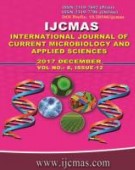


 National Academy of Agricultural Sciences (NAAS)
National Academy of Agricultural Sciences (NAAS)

|
PRINT ISSN : 2319-7692
Online ISSN : 2319-7706 Issues : 12 per year Publisher : Excellent Publishers Email : editorijcmas@gmail.com / submit@ijcmas.com Editor-in-chief: Dr.M.Prakash Index Copernicus ICV 2018: 95.39 NAAS RATING 2020: 5.38 |
Rice being staple food has additional qualities beyond its nutritive value with high degree of digestibility and least allergic properties compared to other cereal grains (Leena kumary, 2004). Traditional rice landraces in India and across Asia are under serious threat of extinction due to cultivation of modern and high yielding varieties (HYVs), hybrids and genetically engineered rice (Yogesh, 2011). The red rice varieties with appealing red colour, has more complex taste and contains more nutrition, fibre-filled bran compared to normal rice. In the red rice, colour is confined to the bran layer, ranging from light red to dark red, a tinge of red remains even after a high degree of milling and contains polyphenols, anthocyanin and possess antioxidant properties. The inner portion of red and the normal white rice consumed is alike and white. The zinc and iron content of red rice is two to three times higher than that of white rice (Ramaiah and Rao, 1953). Rice is considered as food with high carbohydrate and some amount of protein, but has a number of unknown properties, as reported in ancient Indian Ayurvedic literature, where apart from consumption, the scientific literatures like ‘SusruthaSamhitha’ and ‘CharakaSamhitha’- 1000 BC had given evidences of few rice varieties that had the “medicinal properties” and were used for treating human ailments since long time in our country, certain rice landraces are still popular even now among farming community. The rice landraces, due to their adaptability to different agro climatic conditions, unique characteristics and special use are confined to only certain rice growing areas in particular season. The recent studies also recommend rice as a novel food due to its high glycemic index for lowering the incidence of certain lifestyle - related diseases such as heart attack, diabetes and cancer (Rhodes, 2008).
 |
 |
 |
 |
 |